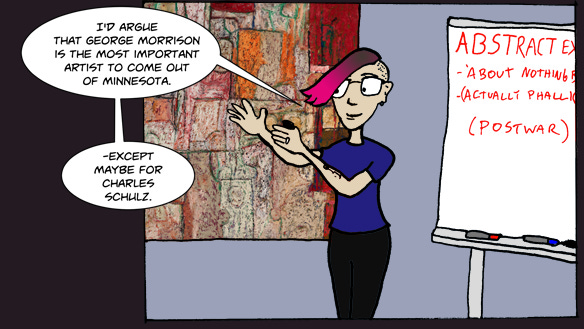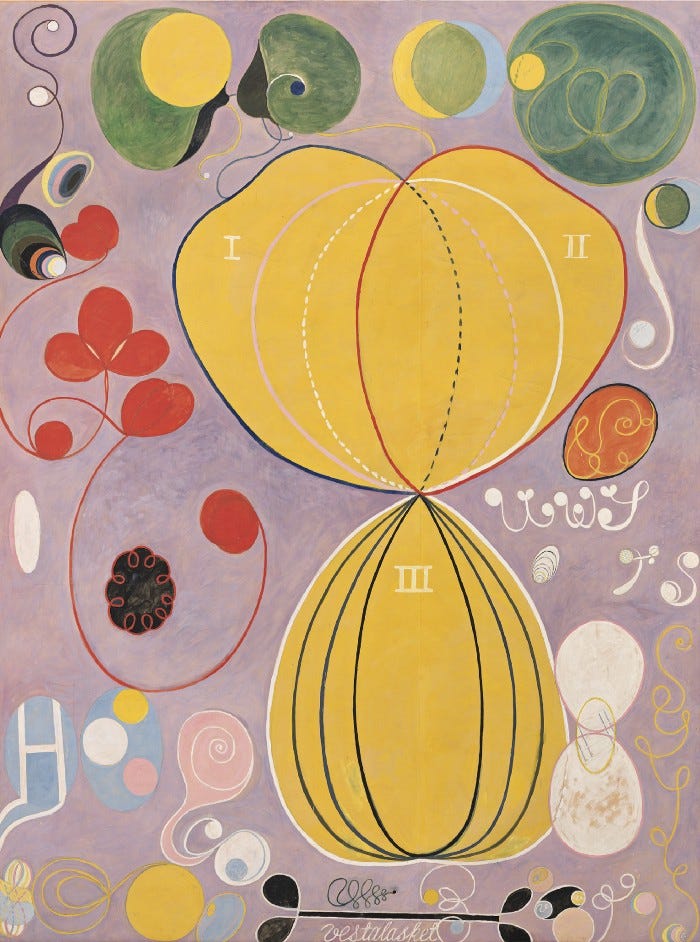Abstract Expressionism: Not the Sausage Party We Were Led to Believe
who’s ready to talk historiography?!?!? (I swear it's cool)
Hey, There,
OK, so today I want to pull the weird trick of both talking about a thing and then also talking about the way we talk about it.
Let me back up and start over: since I’ve been in the art history game at whatever level, it’ been pretty wild to watch the public narrative about the Abstract Expressionists change in real time. And I think that the way that narrative has changed has also pretty solidly reflected changes in our broader society, and what we’ve been looking for in the phenomenon. Which is pretty hilarious, because Abstract Expressionism in general is the genre where individual paintings have no meaning except for what you impose on them from the outside.

Blue Poles, Jackson Pollock, 1952
Here’s what stays pretty constant in the Abstract Expressionist narrative: it was a major American direction in painting in the mid 20th century, representing the point at which American artists (or at least artists working in America) became the epicenter of the capital-letter Art World. It got rolling in Europe, but took off in the US after the war. The big figures of its high phase represent the names you hear the most often lazily associated with “modern art:” Pollock, Rothko, de Kooning. The paintings, as the name implies, are non-representational and, to borrow a description from Kurt Vonnegut, about nothing but themselves.

No. 3/No. 13, Mark Rothko, 1949
I think everything in that paragraph stands at least as “generally still accepted as true, if simplified or grotesquely incomplete.” But outside of that, the narrative has shifted pretty drastically over the years, and in interesting ways.
When I started paying attention to the art history discourse at some level, the baseline take on the Abstract Expressionists was pretty much what I typed above, with the added bits of “and these guys were absolute heroes because they established the US as an art powerhouse, USA! USA!” And that triumphalism actually became the first part of the narrative shift that I saw happen about the Abstract Expressionists, that they were actually stooges of the CIA who were weaponized as a cultural weapon in the Cold War*.
*FWIW, my take on this as an art historian and person who’s read a lot about the Cold War: this claim is clearly true, but for a while got drastically oversold. The CIA just took something that was already resonating and tried to amplify it for their own purposes; they did the same thing with jazz music, midcentury literary fiction and, somehow, maybe, hair metal.
This narrative has never really gone away, although it’s kind of receded from the forefront. When I started grad school, and in particular got interested in feminist approaches to art history, I ran into a new interpretation of the Abstract Expressionists: that they sucked because they were an exclusionary group of white men, often forcing the women in their lives to subordinate themselves in support of their “genius” (the archetypal case here being Lee Krasner putting her career as a painter on the back burner to support her husband Jackson Pollock as he took off). This take also pointed out that, from a certain point of view, making paintings that are about nothing is an extreme expression of privilege, basically inadvertently saying that you don’t have any serious problems you feel like discussing.
This all kind of blew my mind when I heard it, and I digested it and decided that, despite running counter to what I’d always heard about the AEs, there was definitely a lot to it (although I could never stop loving Rothko). I absorbed this point of view to thoroughly that it crept into a panel of a comic I made in 2017 where a character is teaching an art history class:

panel from Nowhere Band vol. 3, 2017; note the stuff on the whiteboard.
But then a couple of years ago, something wild happened. The narrative shifted again. This started, or at least gained a lot of public steam, with the publication and success of Mary Gabriel’s book Ninth Street Women, which was an exhaustive look at the careers of Lee Krasner, Elaine de Kooning, Grace Hartigan, Joan Mitchell, and Helen Frankenthaler. These women, Gabriel argued, had always been crucial parts of Abstract Expressionism. They engaged with the famous men as peers (with the sort of bumps you would sadly expect in the mid 20th century; the Krasner-Pollock situation certainly was complicated), and did work that was influential and groundbreaking. And then they had just kind of been airbrushed out by history. In other words, the movement itself wasn’t sexist and exclusionary (or at least not totally), it’s just the narrative about it that was.

The Eye Is the First Circle, Lee Krasner, 1960

Sweden, Grace Hartigan, 1959
This again blew my mind. I found Gabriel’s arguments completely convincing (Ninth Street Women is one of the densest books I’ve ever engaged with, just in terms of the amount of evidence mounted behind its argument; this means it’s difficult to zip through, but it also means that Gabriel’s thesis is pretty tough to deny). And this pretty large pivot on what I thought was the solid feminist reading of the AEs really highlighted to me how much our critical lenses can be wrong. By pushing the previous feminist take, I’d been actively erasing women artists. D’oh.
This take was further boosted lately when Rebecca and I watched Beyond the Visible – Hilma af Klint, a (great) documentary about a Swedish painter who made what were undeniably Abstract Expressionist works in the late 19th and early 20th century, before the accepted early stages of the genre. Moreover, her work was exhibited with that of the guy previously credited with the first Abstract Expressionist painting around 1911, Wassily Kandinsky.

The Ten Largest, №7., Adulthood, Group IV, Hilma af Klint, 1907
So, by the current narrative (which, FWIW, is the one I accept as the closest we’ve gotten to the truth), not only were women erased from the high period of Abstract Expressionism, a woman was erased from its very beginning. It’s almost certainly not a cut and dried case that Kandinsky directly ripped off af Klint; on the other hand, it’s also clearly not the cut and dried truth that Kandinsky just created something new out of thin air.
I guess there are two things that I think are worth taking away from here (well, three: the obvious first one is that women were a core part of Abstract Expressionism in all of its phases). One is that all of the narratives that we tell ourselves about history are simplified and incomplete. They kind of have to be, to fit into our brains, and that’s OK, as long as we keep that fact in mind and don’t try to force cause and effect or fudge facts just to fit the narrative. And the other is that these narratives change over time, in response to new information and to changing norms in the culture. I don’t think it’s an accident that women were erased from the story of Abstract Expressionism during a particularly sexist period, nor that they were brought back into it in a time when sexism was being more actively pushed back against. There’s a name for this shift of historical frames and narratives: historiography, and it’s a fascinating rabbithole to dive into.
Right on. Be safe.
RECOMMENDATION
I don’t know what you think of Bruce Springsteen; I go back and forth, although basically I like him a lot more than I like the borderline cult of some of his fandom. But this clip of him doing Van Halen’s “Jump” (with Tom fucking Morello on guitar!)
is just a fantastic musical moment. And it turns out “Springsteen doing fun covers” is very much a thing on YouTube. “Stayin’ Alive!”
“Highway to Hell!”
“Music-loving omnivore” is always a great look.
SOME LINKS
CLOSING STUFF
OK, so here at the bottom, sorry for the ragged copy editing; my deal with myself was to keep this fast and loose, which is gonna mean typos. On the other hand, that also means it’ll actually come out, instead of being obsessed over.
If you have any thoughts/reactions/what have you about this, I’d love to hear about it, either by email or on Twitter. And if you know anybody who might dig this, please forward it on to them, or send ‘em the signup link! And thanks!

